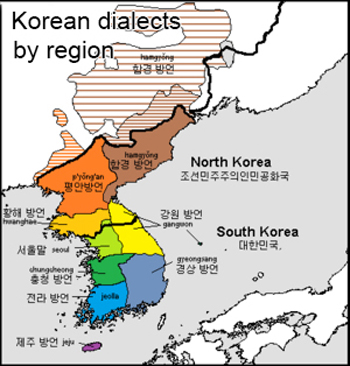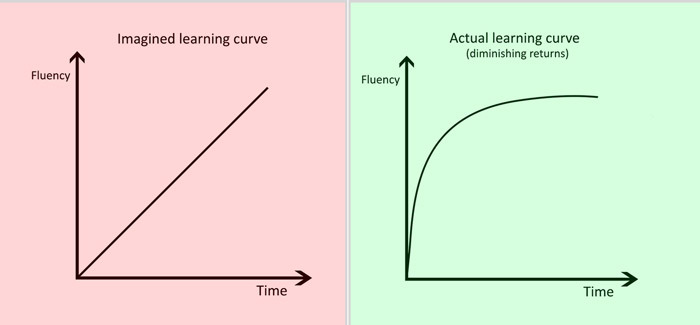View this article in another language
- 한국어
- English
- 日本語
- 中文
- العربية
- Español
- Français
- Deutsch
- Pусский
- Tiếng Việt
- Indonesian
I’ve been learning Korean for the better part of the past 7 years, and in 2014, I became the Grand Prize Winner of the first KBS World Korean Speaking Contest. The contest saw applicants from 44 countries around the world showcase their Korean skills through three rounds of elimination. As the Grand Prize Winner, I was invited to spend a week in Seoul in September 2014, where I participated in various broadcasting events, including on national radio, to showcase my knowledge of the Korean language and culture.

So how did I manage to reach a relatively high level of spoken fluency in Korean, and how can you do it too? If I were to reduce the “secret” to 2 words, it would boil down to motivation and technique. Motivation, because Korean, after all, is ranked by the Foreign Service Institute of the US Department of State as one of the hardest languages to learn for native English speakers (along others such as Japanese and Mandarin Chinese). This means that learning Korean is a considerable investment of time and effort, so you’ll need to be in this for the long-run. You’ll inevitably go through motivation peaks and troughs, but what’s important is not to give up and to keep progressing. And finally technique, because even if you do manage to keep going for a long period of time, you’ll need to have the right tools in your toolkit to avoid plateauing and to improve your skills to a fairly high level. But beyond this, how exactly do you go about learning Korean?
In this article, I’m going to guide you through the exact steps I would recommend you to go through to begin learning Korean from scratch, and to eventually reach a high level of proficiency in it. I’m not going to tell you it’s easy, but it is, without an ounce of a doubt, absolutely worth it. Enjoy the post, and if you find it useful or interesting in any way, please share it!
An overview of Korean: What, Why, and How?
 Korean is the official language of South and North Korea, and it’s one of the two official languages in China’s Yanbian Korean Autonomous Prefecture. It’s spoken by an approximate 80 million people around the world (including large overseas communities such as in Los Angeles and Toronto).
Korean is the official language of South and North Korea, and it’s one of the two official languages in China’s Yanbian Korean Autonomous Prefecture. It’s spoken by an approximate 80 million people around the world (including large overseas communities such as in Los Angeles and Toronto).
If you speak some Chinese, you’ll have a good starting advantage over other learners of Korean, since approximately 60% of Korean vocabulary is derived from Chinese (i.e. Sino-Korean words). If you speak Japanese, you’ll also have a considerably easier time learning Korean, since both languages—and up to a certain point, cultures—share many similarities, such as a similar order of words (subject-object-verb) and grammar. While many linguists classify Korean as a “language isolate” (i.e. not part of any other language family), some also consider it to be part of the Altaic language family.
So why would anyone want to learn Korean? Well, for starters, the language has gained a tremendous amount of popularity in the past decade, not least thanks to the so-called “Hallyu” (한류), or “Korean wave” as it is known in English. The Korean Wave evolved from a regional development (mostly Southeast and East Asia) into a global phenomenon due to the proliferation of Korean dramas (TV series) and Korean pop (K-pop) music videos on YouTube, of which Gangnam Style is but one prominent example.
So, in earnest, let’s look at the steps you’ll need to take to effectively learn Korean.
1. Set clear goals, a timeline, and a schedule
Here’s the secret to a successful start, in 3 simple bullet points:
Your goals must be specific. Vague, sweeping goals are too broad to be acted upon.
Your goals must be believable. If you don’t believe you can reach them, you won’t.
Your goals must be challenging and demanding.
A lot of language learners fail to reach a respectable level of fluency because they lack any clear goals and direction, and they have no regular study schedule. Don’t fall into this trap. Even before purchasing any learning materials, set yourself some very clear goals and a roadmap to reach these goals. More importantly, strongly believe in them and do whatever it takes to reach them.
Having goals helps you to track your progress and gives you a sense of direction. This in turns helps to increase motivation, and reduces your chances of giving up. Make your goals ambitious but realistic. I wrote an entire post dedicated to the importance of goals, so have a look through it for a more in-depth look at the importance of setting goals.
2. Get a good textbook/method
Getting a good textbook with which you’ll be able to work with for the next couple of months is a crucial step to the long and interesting voyage that learning a language is. I’ve seen a LOT of Korean textbooks and learning materials out there, and I’ve tested more than my fair share. Below I’ve listed what, in my opinion, are easily some of the best ones out there. Pick one or two (but no more), and go through them in a consistent, regular manner. It’s as easy as that.
Top picks:
Elementary Korean, Second Edition, by Ross King and Jaehoon Yeon
Korean Made Easy for Beginners, by Seung-eun Oh
Korean Made Simple: A beginner’s guide to learning the Korean language, by BillyGo
Living Language Korean, by Living Language and Jaemin Roh
Spoken World: Korean – A Complete Course for Beginners, by Living Language
Glossika Korean (Mass Sentence Method – for intermediate learners), by Glossika
3. Learn Hangul
Now that you have your newly purchased, glossy shiny textbook, it’s time to learn Hangul (한글). Yep, it’s one of the very first things you should do before getting too absorbed in your studies.
 So what is Hangul? Very simply put, Hangul is the Korean alphabet and the official script of both South and North Korea (don’t confuse “Hangul” with the name for “Korean language” in Korean, Hangukeo (한국어)). For over a millennium and up until the first half of the 20th century, Korean was written with adapted Chinese characters called hanja. However, Koreans now almost exclusively use the Hangul alphabet. You can easily live in Korea without knowing a single Chinese character, although it’s always helpful to know a few (or many), especially if you wish to learn Korean up to an advanced level. For example, in many news headlines Chinese characters are still used for brevity’s sake, and characters are also often used in between parenthesis to help clarify the meaning of a word that has many different meanings.
So what is Hangul? Very simply put, Hangul is the Korean alphabet and the official script of both South and North Korea (don’t confuse “Hangul” with the name for “Korean language” in Korean, Hangukeo (한국어)). For over a millennium and up until the first half of the 20th century, Korean was written with adapted Chinese characters called hanja. However, Koreans now almost exclusively use the Hangul alphabet. You can easily live in Korea without knowing a single Chinese character, although it’s always helpful to know a few (or many), especially if you wish to learn Korean up to an advanced level. For example, in many news headlines Chinese characters are still used for brevity’s sake, and characters are also often used in between parenthesis to help clarify the meaning of a word that has many different meanings.
Hangul is composed of fourteen consonants and ten vowels, in addition to having double consonants and “clustered” consonants. Because of this, Hangul is in fact really easy to learn. You should NOT learn Korean by reading the Romanized script. It’s a bad habit and simply not a smart thing to do. If you put one or two hours learning Hangul for the next couple of days, I guarantee you that you’ll be able to read by the end of the week. Even if you’re planning a short trip to Korea no longer than a week or two, I would still highly encourage you to learn the script.
4. Find a bunch of awesome tools online
 These days it’s amazing the amount of great language learning tools and resources that you can find online. One of the first things you’ll need along with your textbook and newly-equipped Hangul reading skills, is a good online dictionary. Here are three very good ones (the last is for beginners but in Korean only):
These days it’s amazing the amount of great language learning tools and resources that you can find online. One of the first things you’ll need along with your textbook and newly-equipped Hangul reading skills, is a good online dictionary. Here are three very good ones (the last is for beginners but in Korean only):
Naver
Daum
한국어기초사전 (Korean Dictionary for Beginners)
Here’s a bunch of awesome websites and podcasts:
Talk To Me In Korean
Korean Champ
KBS World (check out their radio programs)
Lingholic
Here are news websites that are available both in Korean and English (and/or other languages):
Korea Times (this resource is great because it often contains the English AND translated Korean version of the article)
Korea Joongang Daily (look for the “bilingual column” on the right)
Yonhap News (available in multiple languages)
TED Talks (read the transcripts of TED Talks in English first, and then try your hand at the Korean translated version! There’s also TEDxSeoul and TEDxBusan, which are entirely in Korean)
5. Get exposed to as many sentences and dialogues as possible
Now that you’ve developed a solid and consistent daily study routine, you’ll need to get exposed to as many sentences and dialogues as possible. For example, if you’re working through a textbook such as the Living Language Korean series, you’ll get the chance to go through dialogues in every unit. Go through them repeatedly and ensure that you review each unit regularly.
It’s important, when working with learning materials, to repeat loudly the sentences that you read (unless you’re in a public place!). This will get your tongue and ear slowly used to pronouncing and hearing the language properly. Also, do bi-directional translation exercises in which you work with the Korean dialogue only during one day (and translate it into your native tongue), and do the opposite any other day.
6. Learn as much about the culture as possible
 You may well have the largest vocabulary in the world in any given language, but if you’re clueless about the culture, you won’t know which words to use in any given situation at any given time. Unless you’re from East Asia, chances are that Korean culture is significantly different from yours. From my point of view, that’s exciting news, and discovering an entirely new and different culture is an enriching experience that really adds a lot of spices to your life.
You may well have the largest vocabulary in the world in any given language, but if you’re clueless about the culture, you won’t know which words to use in any given situation at any given time. Unless you’re from East Asia, chances are that Korean culture is significantly different from yours. From my point of view, that’s exciting news, and discovering an entirely new and different culture is an enriching experience that really adds a lot of spices to your life.
So how can you get to know about Korean culture? For starters, find a good history book and start learning a bit about the country’s history. One of my favorite books is by far Bruce Cumings’ Korea’s Place in the Sun: A Modern History, but there are literally thousands of good books on Korea out there. Next, and I’ll come back to this at point #8, as you’ll watch Korean dramas and movies and listen to Korean music, you’ll inevitably get exposed to the culture. Pay attention and take some notes!
7. Find a tutor or a language exchange partner
Wherever in the world you find yourself right now, you’re reading this because you have access to the internet. Whether at home or in a library or café, internet brings you an amazing array of wonderful resources and technologies to help you practice your target language.
Once you’ve learned a bit of Korean, you’ve gotten to know more about the culture, and you’re eager to practice your speaking skills with an actual human being, it’s time to make the great leap forward and start chatting with natives—the sooner the better. If you don’t live in Korea or in a place where many Koreans live, you’ll probably have to fall back on finding tutors or language exchange partners on the internet.
Not to worry, though, because there are amazing websites that do just that. One that I can recommend, since I’ve tried it a number of times, is Italki. At the time of writing this article, eight professional teachers and 40 community tutors are teaching Korean on the site. Prices vary, but for around USD $10 to $15 an hour, you can have a private tutor who will help you practice and develop your speaking skills in the language. If you don’t feel like spending money, don’t worry, you can always find language partners for totally free and practice over Skype, but then you would usually be expected to also teach your native language in return.
8. Get exposed to as many engaging materials as you possibly can
As you progress through your Korean learning adventure and reach a level that allows you to access and understand a wider array of materials, it’s time to give your textbook a break and get exposed to as many engaging materials as possible. I’ve written an article that introduces people to Korean Indie music, so if you’re eager to discover interesting Korean music, check it out.
These days it’s also easy to watch Korean movies and dramas online. YouTube is of course a very useful resource, but if you wish to actually download stuff, check out websites such as Dramaload.
A quick search on your favorite search engine will yield hundreds of other good sites. Finally, use Amazon’s awesome “language” filter and look for popular books in Korean and get them mailed to you directly at your doorstep.
9. You’ll feel like you’ve reached a plateau. Don’t give up
Almost everybody, no matter how experienced they are at learning languages, feels like they stop making progress in their target language at one point or another in time. That’s normal. I’ve written a detailed post about reaching plateaus, so you might want to have a look at it.
Essentially, a lot of us feel like we reach plateaus at a certain point in time while in fact all what’s happening is that we simply learn at a slower pace. At the beginning when you start from a blank slate, you feel like you’re making a lot of progress quickly, since it’s easy to see how many new words you can now recognize compared to the previous day or week. However, as time goes by, the same amount of time invested in learning a language will yield smaller returns; in other words, our learning curve is not linear, but rather round-shaped (see the graph below). Don’t worry about it and remind yourself that it’s absolutely normal to feel this way. Just keep enjoying the language and don’t give up!
10. Make the language part of your life

Think about this for a moment: what are the things that you do every day in your native tongue? Just how many hours a day do you spend watching TV, reading the news, and talking with friends? Once you’ve reached a low intermediate level in the language, it’s time to really make it part of your life.
Whatever you enjoy doing in your native tongue can be enjoyed in a foreign language. Don’t see Korean as something you have to “study”, but rather something you can enjoy. Plus, make an effort to really immerse yourself in the language, by, for example, changing your language settings to Korean for things such as Facebook, YouTube, or even on your cellphone.
11. Plan a trip to Korea
 That’s it. You’ve made it all the way up until here. You’ve kept your motivation high, consistently for a long period of time. You had clear goals when you started and you feel like you’ve reached a lot of them. In fact, maybe one of your goals was to visit Korea. Well now’s the time to actually do it!
That’s it. You’ve made it all the way up until here. You’ve kept your motivation high, consistently for a long period of time. You had clear goals when you started and you feel like you’ve reached a lot of them. In fact, maybe one of your goals was to visit Korea. Well now’s the time to actually do it!
If you want to work in Korea, you might want to consider teaching English there. Otherwise, why not travel around the peninsula for a few weeks and practice your newly-acquired Korean speaking skills? This will sure turn to be a memorable trip.
12. Find more engaging material, and keep going
Language learning is a lifelong journey with no clear destination. After all, you’ve begun this journey to enjoy the trip itself, didn’t you? Once you’ve reached an intermediate to high level of proficiency, just keep doing what’s worked for you up until now. Read interesting blogs, watch more movies, find literary gems, and, who knows, you might one day call Korea home!
Conclusion
That’s it. I’ve just shared with you what well over 7 years of experience learning Korean has taught me. Has this been useful to you in any kind of way? I sure do hope so! If you have any questions, remember that I always love to help others and I would be more than happy to respond to whatever you have in your mind. Let us know in the comments below why you’re interested in Korean, and if you’ve been learning it for some time, how your studies are going!
By Sam Gendreau
Blog site: http://korcan50years.com/2015/05/24/how-to-become-fluent-in-korean/comment-page-1/#comment-27095

So how did I manage to reach a relatively high level of spoken fluency in Korean, and how can you do it too? If I were to reduce the “secret” to 2 words, it would boil down to motivation and technique. Motivation, because Korean, after all, is ranked by the Foreign Service Institute of the US Department of State as one of the hardest languages to learn for native English speakers (along others such as Japanese and Mandarin Chinese). This means that learning Korean is a considerable investment of time and effort, so you’ll need to be in this for the long-run. You’ll inevitably go through motivation peaks and troughs, but what’s important is not to give up and to keep progressing. And finally technique, because even if you do manage to keep going for a long period of time, you’ll need to have the right tools in your toolkit to avoid plateauing and to improve your skills to a fairly high level. But beyond this, how exactly do you go about learning Korean?
In this article, I’m going to guide you through the exact steps I would recommend you to go through to begin learning Korean from scratch, and to eventually reach a high level of proficiency in it. I’m not going to tell you it’s easy, but it is, without an ounce of a doubt, absolutely worth it. Enjoy the post, and if you find it useful or interesting in any way, please share it!
An overview of Korean: What, Why, and How?

If you speak some Chinese, you’ll have a good starting advantage over other learners of Korean, since approximately 60% of Korean vocabulary is derived from Chinese (i.e. Sino-Korean words). If you speak Japanese, you’ll also have a considerably easier time learning Korean, since both languages—and up to a certain point, cultures—share many similarities, such as a similar order of words (subject-object-verb) and grammar. While many linguists classify Korean as a “language isolate” (i.e. not part of any other language family), some also consider it to be part of the Altaic language family.
So why would anyone want to learn Korean? Well, for starters, the language has gained a tremendous amount of popularity in the past decade, not least thanks to the so-called “Hallyu” (한류), or “Korean wave” as it is known in English. The Korean Wave evolved from a regional development (mostly Southeast and East Asia) into a global phenomenon due to the proliferation of Korean dramas (TV series) and Korean pop (K-pop) music videos on YouTube, of which Gangnam Style is but one prominent example.
So, in earnest, let’s look at the steps you’ll need to take to effectively learn Korean.
1. Set clear goals, a timeline, and a schedule
Here’s the secret to a successful start, in 3 simple bullet points:
Your goals must be specific. Vague, sweeping goals are too broad to be acted upon.
Your goals must be believable. If you don’t believe you can reach them, you won’t.
Your goals must be challenging and demanding.
A lot of language learners fail to reach a respectable level of fluency because they lack any clear goals and direction, and they have no regular study schedule. Don’t fall into this trap. Even before purchasing any learning materials, set yourself some very clear goals and a roadmap to reach these goals. More importantly, strongly believe in them and do whatever it takes to reach them.
Having goals helps you to track your progress and gives you a sense of direction. This in turns helps to increase motivation, and reduces your chances of giving up. Make your goals ambitious but realistic. I wrote an entire post dedicated to the importance of goals, so have a look through it for a more in-depth look at the importance of setting goals.
2. Get a good textbook/method
Getting a good textbook with which you’ll be able to work with for the next couple of months is a crucial step to the long and interesting voyage that learning a language is. I’ve seen a LOT of Korean textbooks and learning materials out there, and I’ve tested more than my fair share. Below I’ve listed what, in my opinion, are easily some of the best ones out there. Pick one or two (but no more), and go through them in a consistent, regular manner. It’s as easy as that.
Top picks:
Elementary Korean, Second Edition, by Ross King and Jaehoon Yeon
Korean Made Easy for Beginners, by Seung-eun Oh
Korean Made Simple: A beginner’s guide to learning the Korean language, by BillyGo
Living Language Korean, by Living Language and Jaemin Roh
Spoken World: Korean – A Complete Course for Beginners, by Living Language
Glossika Korean (Mass Sentence Method – for intermediate learners), by Glossika
3. Learn Hangul
Now that you have your newly purchased, glossy shiny textbook, it’s time to learn Hangul (한글). Yep, it’s one of the very first things you should do before getting too absorbed in your studies.

Hangul is composed of fourteen consonants and ten vowels, in addition to having double consonants and “clustered” consonants. Because of this, Hangul is in fact really easy to learn. You should NOT learn Korean by reading the Romanized script. It’s a bad habit and simply not a smart thing to do. If you put one or two hours learning Hangul for the next couple of days, I guarantee you that you’ll be able to read by the end of the week. Even if you’re planning a short trip to Korea no longer than a week or two, I would still highly encourage you to learn the script.
4. Find a bunch of awesome tools online

Naver
Daum
한국어기초사전 (Korean Dictionary for Beginners)
Here’s a bunch of awesome websites and podcasts:
Talk To Me In Korean
Korean Champ
KBS World (check out their radio programs)
Lingholic
Here are news websites that are available both in Korean and English (and/or other languages):
Korea Times (this resource is great because it often contains the English AND translated Korean version of the article)
Korea Joongang Daily (look for the “bilingual column” on the right)
Yonhap News (available in multiple languages)
TED Talks (read the transcripts of TED Talks in English first, and then try your hand at the Korean translated version! There’s also TEDxSeoul and TEDxBusan, which are entirely in Korean)
5. Get exposed to as many sentences and dialogues as possible
Now that you’ve developed a solid and consistent daily study routine, you’ll need to get exposed to as many sentences and dialogues as possible. For example, if you’re working through a textbook such as the Living Language Korean series, you’ll get the chance to go through dialogues in every unit. Go through them repeatedly and ensure that you review each unit regularly.
It’s important, when working with learning materials, to repeat loudly the sentences that you read (unless you’re in a public place!). This will get your tongue and ear slowly used to pronouncing and hearing the language properly. Also, do bi-directional translation exercises in which you work with the Korean dialogue only during one day (and translate it into your native tongue), and do the opposite any other day.
6. Learn as much about the culture as possible

So how can you get to know about Korean culture? For starters, find a good history book and start learning a bit about the country’s history. One of my favorite books is by far Bruce Cumings’ Korea’s Place in the Sun: A Modern History, but there are literally thousands of good books on Korea out there. Next, and I’ll come back to this at point #8, as you’ll watch Korean dramas and movies and listen to Korean music, you’ll inevitably get exposed to the culture. Pay attention and take some notes!
7. Find a tutor or a language exchange partner
Wherever in the world you find yourself right now, you’re reading this because you have access to the internet. Whether at home or in a library or café, internet brings you an amazing array of wonderful resources and technologies to help you practice your target language.
Once you’ve learned a bit of Korean, you’ve gotten to know more about the culture, and you’re eager to practice your speaking skills with an actual human being, it’s time to make the great leap forward and start chatting with natives—the sooner the better. If you don’t live in Korea or in a place where many Koreans live, you’ll probably have to fall back on finding tutors or language exchange partners on the internet.
Not to worry, though, because there are amazing websites that do just that. One that I can recommend, since I’ve tried it a number of times, is Italki. At the time of writing this article, eight professional teachers and 40 community tutors are teaching Korean on the site. Prices vary, but for around USD $10 to $15 an hour, you can have a private tutor who will help you practice and develop your speaking skills in the language. If you don’t feel like spending money, don’t worry, you can always find language partners for totally free and practice over Skype, but then you would usually be expected to also teach your native language in return.
8. Get exposed to as many engaging materials as you possibly can
As you progress through your Korean learning adventure and reach a level that allows you to access and understand a wider array of materials, it’s time to give your textbook a break and get exposed to as many engaging materials as possible. I’ve written an article that introduces people to Korean Indie music, so if you’re eager to discover interesting Korean music, check it out.
These days it’s also easy to watch Korean movies and dramas online. YouTube is of course a very useful resource, but if you wish to actually download stuff, check out websites such as Dramaload.
A quick search on your favorite search engine will yield hundreds of other good sites. Finally, use Amazon’s awesome “language” filter and look for popular books in Korean and get them mailed to you directly at your doorstep.
9. You’ll feel like you’ve reached a plateau. Don’t give up
Almost everybody, no matter how experienced they are at learning languages, feels like they stop making progress in their target language at one point or another in time. That’s normal. I’ve written a detailed post about reaching plateaus, so you might want to have a look at it.
Essentially, a lot of us feel like we reach plateaus at a certain point in time while in fact all what’s happening is that we simply learn at a slower pace. At the beginning when you start from a blank slate, you feel like you’re making a lot of progress quickly, since it’s easy to see how many new words you can now recognize compared to the previous day or week. However, as time goes by, the same amount of time invested in learning a language will yield smaller returns; in other words, our learning curve is not linear, but rather round-shaped (see the graph below). Don’t worry about it and remind yourself that it’s absolutely normal to feel this way. Just keep enjoying the language and don’t give up!
10. Make the language part of your life

Think about this for a moment: what are the things that you do every day in your native tongue? Just how many hours a day do you spend watching TV, reading the news, and talking with friends? Once you’ve reached a low intermediate level in the language, it’s time to really make it part of your life.
Whatever you enjoy doing in your native tongue can be enjoyed in a foreign language. Don’t see Korean as something you have to “study”, but rather something you can enjoy. Plus, make an effort to really immerse yourself in the language, by, for example, changing your language settings to Korean for things such as Facebook, YouTube, or even on your cellphone.
11. Plan a trip to Korea

If you want to work in Korea, you might want to consider teaching English there. Otherwise, why not travel around the peninsula for a few weeks and practice your newly-acquired Korean speaking skills? This will sure turn to be a memorable trip.
12. Find more engaging material, and keep going
Language learning is a lifelong journey with no clear destination. After all, you’ve begun this journey to enjoy the trip itself, didn’t you? Once you’ve reached an intermediate to high level of proficiency, just keep doing what’s worked for you up until now. Read interesting blogs, watch more movies, find literary gems, and, who knows, you might one day call Korea home!
Conclusion
That’s it. I’ve just shared with you what well over 7 years of experience learning Korean has taught me. Has this been useful to you in any kind of way? I sure do hope so! If you have any questions, remember that I always love to help others and I would be more than happy to respond to whatever you have in your mind. Let us know in the comments below why you’re interested in Korean, and if you’ve been learning it for some time, how your studies are going!
By Sam Gendreau
Blog site: http://korcan50years.com/2015/05/24/how-to-become-fluent-in-korean/comment-page-1/#comment-27095